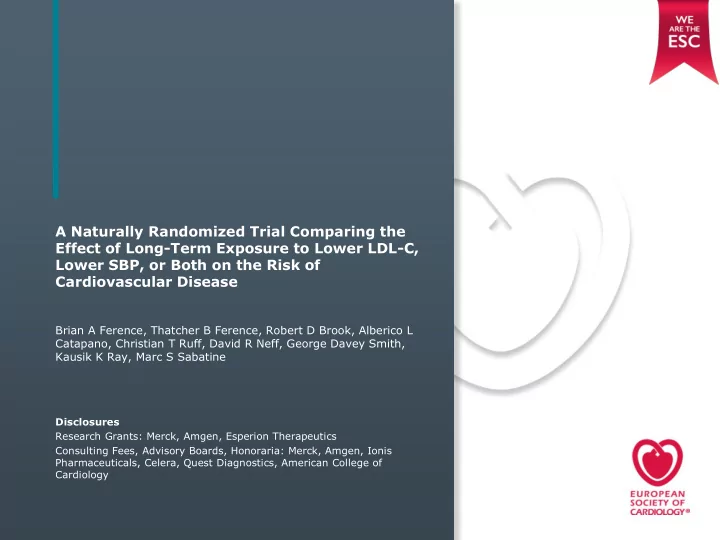

A Naturally Randomized Trial Comparing the Effect of Long-Term Exposure to Lower LDL-C, Lower SBP, or Both on the Risk of Cardiovascular Disease Brian A Ference, Thatcher B Ference, Robert D Brook, Alberico L Catapano, Christian T Ruff, David R Neff, George Davey Smith, Kausik K Ray, Marc S Sabatine Disclosures Research Grants: Merck, Amgen, Esperion Therapeutics Consulting Fees, Advisory Boards, Honoraria: Merck, Amgen, Ionis Pharmaceuticals, Celera, Quest Diagnostics, American College of Cardiology
Speaker
Background Persons with ideal risk factor profiles have a very low lifetime risk of CVD • fewer than 5% of persons are able to maintain ideal risk factor profiles • Mendelian randomization studies have shown that LDL-C and SBP each • have both causal and cumulative effects on the risk of CVD Because LDL-C and SBP have cumulative effects over time, a simplified • prevention strategy that focuses on promoting long-term exposure to both lower LDL-C and lower SBP may be a very effective prevention strategy The causal effect of combined exposure to LDL-C and SBP on CVD is • unknown Prospective epidemiologic studies suggest the effect may be more than • additive but less than multiplicative A recent 2x2 factorial randomized trial (HOPE-3) suggested the benefit of • combined LDL-C and SBP lowering was not greater than LDL lowering alone Brian A Ference, MD, MPhil, MSc FACC
Purpose and key points about methods Purpose To estimate the causal effect of combined exposure to lower LDL-C and lower SBP • on the risk of cardiovascular events To estimate the potential clinical benefit of a parsimonious prevention strategy • that focuses on promoting long-term exposure to the combination of one mmol/L lower LDL-C and 10 mmHg lower SBP Methods We used genetic LDL and BP scores as instruments to “naturally randomize” • 102,000 study participants to lower LDL-C, lower SBP, both or neither using a 2x2 factorial Mendelian randomization study design The genetic scores were not used to predict risk, but instead were used merely as • convenient instruments to “naturally randomize” study participants The study therefore evaluated the unconfounded causal effect of random • allocation to lower LDL, lower SBP and combined exposure to both on the risk of cardiovascular events in a manner analogous to a long-term randomized trial Brian A Ference, MD, MPhil, MSc FACC
Results A total of 14,368 major vascular events (MVE: CHD death, MI, stroke or • coronary revascularizations) occurred during up to 32 years of follow-up When present together, lower LDL and lower SBP had independent, multiplicative • and cumulative causal effects on the risk of CV events Long-term exposure to the combination of 1 mmol/L lower LDL-C and 10 mmHg • lower SBP was associated with an 86.1% (OR: 0.139, 95%CI:0.114-0.170, p=1.6x10 -83 ) lower risk of MVE Combined exposure to lower LDL and lower SBP was associated with a • significantly greater reduction in the risk of MVE as compared to lower LDL alone (p=1.4x10 -14 ) and to lower SBP alone (p=1.8x10 -23 ) The effect of combined exposure to lower LDL-C and lower SBP was consistent • across multiple different cardiovascular end points (including CHD death) The effect was similar in men & women; smokers & non-smokers; diabetics & • non-diabetics; persons with LDL-C above and below 3.5 mmol/L, and persons with SBP above and below 120 mmHg Brian A Ference, MD, MPhil, MSc FACC
Conclusions LDL-C and SBP have independent, multiplicative and cumulative causal • effects on the risk of cardiovascular events Because their effects are multiplicative and cumulative, long-term exposure • to the combination of modestly lower LDL-C and SBP has the potential to dramatically reduce the lifetime risk of cardiovascular events, even among persons with apparently normal cholesterol and blood pressure levels Our study confirms that cardiovascular events are largely preventable • The prevention of cardiovascular disease can be substantially improved and • simplified by designing prevention programs that focus on promoting long- term exposure to combination of lower LDL-C and lower SBP beginning in early adulthood Brian A Ference, MD, MPhil, MSc FACC
Recommend
More recommend